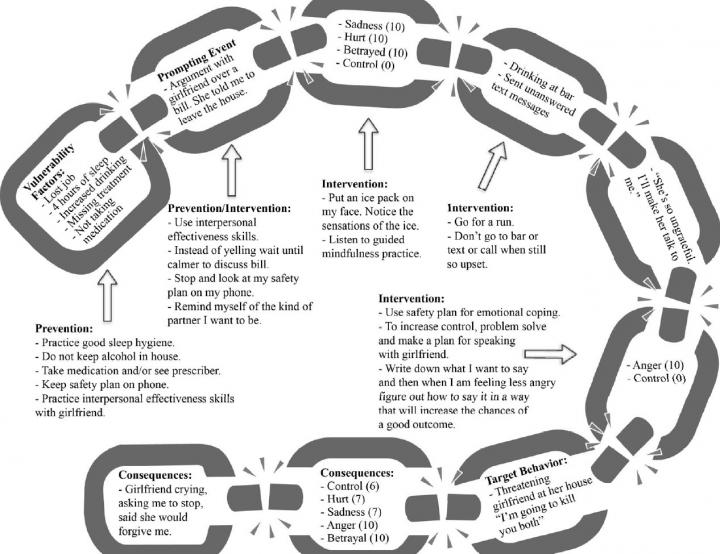
Credit: Journal of Psychiatric Practice
May 6, 2021 – With mass shootings and other seemingly meaningless acts of violence in the headlines all too frequently, strategies to assess the risk and reduce the potential for violent acts are sorely needed. The fourth in a series of five columns devoted to therapeutic risk management of violence – focusing on a method called chain analysis to identify and target pathways leading to violent thoughts and behaviors – appears in the May issue of the Journal of Psychiatric Practice. The journal is published in the Lippincott portfolio by Wolters Kluwer.
An innovative model for therapeutic risk management of the potentially violent patient has been developed by Hal Wortzel, MD, and colleagues of the Rocky Mountain Mental Illness Research, Education and Clinical Center (MIRECC) at the VA Rocky Mountain Regional Medical Center (RMRMC), Aurora, Colo. The authors note that “Adding chain analysis builds on the structural assessment of violence risk discussed in our previous columns, and can be crucial to guiding effective, individually focused interventions to prevent future other-directed violence.”
Chain analysis targets pathways leading to violence
In a previous series, Dr. Wortzel and colleagues shared their approach to assessing the risk of self-directed violence (SDV) in potentially suicidal patients. The authors emphasized the benefits of a patient-centered model that supports the patient’s overall treatment and the therapeutic alliance with mental health professionals.
In a new series, the therapeutic risk management approach is applied to patients at risk for other-directed violence (ODV) – borrowing from the SDV risk assessment skills that many clinicians already have. For the next two months, the series can be freely accessed on the journal website. The three previously published articles have focused on:
- Clinical risk assessment starts with a clinical interview to assess the risk of ODV, including the circumstances in which clinicians have a legal duty to warn and protect. Assessing violence risk can form an integral part of providing competent and compassionate mental health care: a trusting therapeutic relationship facilitates the ability to elicit details pertaining to violence risk, as well as to institute therapies that might mitigate risk for future violent behaviors.
- Structured screening or assessment tools to augment clinical assessment of ODV. Tools include the Violence Risk Screening-10 (V-RISK-10), appropriate for use in psychiatric inpatient and community care; and the Violence Screening and Assessment of Needs (VIO-SCAN), specifically designed for use with military Veterans.
- Risk stratification, illustrated by the case scenario of a Veteran with posttraumatic stress disorder (PTSD) and polysubstance use disorder who has made angry and violent threats. Risk of ODV can be assessed in terms of both the severity and temporality (acute versus chronic) of the risk – helping to guide critical decisions as to patient management and the duty to warn.
Published yesterday, the fourth column in the series describes chain analysis as a key tool in therapeutic management of ODV. Using the same case scenario involving a Veteran with PTSD, the authors demonstrate how to apply chain analysis to identify pathways of reinforcement that can cause violent ideas and behaviors to persist. In this case, the Veteran was able to recognize that experiencing sadness and hurt caused him to feel vulnerable and out of control in a difficult personal situation – while aggressive behavior and violent threats led to a sense of feeling in control. The use of chain analysis led to identification of interventional strategies to disrupt the chain – and ultimately reduce the risk for violence.
The fifth and final part of the series, scheduled for publication in July 2021, will discuss safety planning as a critical component of therapeutic risk management of violence. The authors will provide recommendations for using this innovative strategy to therapeutically mitigate the risk of ODV.
Dr. Wortzel and colleagues hope their series will provide mental health professionals with a “cogent process” for conducting violence risk assessments in a way that fulfills legal and ethical responsibilities, protects the safety of patients and potential victims, and supports the patient’s overall mental health care.
Click here to read “Therapeutic Risk Management for Violence: Chain Analysis of Other-Directed Violent Ideation and Behavior.”
DOI: 10.1097/PRA.0000000000000552
###
About Journal of Psychiatric Practice
Journal of Psychiatric Practice®, a peer reviewed journal, publishes reports on new research, clinically applicable reviews, articles on treatment advances, and case studies, with the goal of providing practical and informative guidance for clinicians. Mental health professionals will want access to this journal¬–for sharpening their clinical skills, discovering the best in treatment, and navigating this rapidly changing field. John M. Oldham, MD, is the editor in chief and past president of the American Psychiatric Association.
About Wolters Kluwer
Wolters Kluwer (WKL) is a global leader in professional information, software solutions, and services for the clinicians, nurses, accountants, lawyers, and tax, finance, audit, risk, compliance, and regulatory sectors. We help our customers make critical decisions every day by providing expert solutions that combine deep domain knowledge with advanced technology and services.
Wolters Kluwer reported 2020 annual revenues of €4.6 billion. The group serves customers in over 180 countries, maintains operations in over 40 countries, and employs approximately 19,200 people worldwide. The company is headquartered in Alphen aan den Rijn, the Netherlands.
Wolters Kluwer provides trusted clinical technology and evidence-based solutions that engage clinicians, patients, researchers and students in effective decision-making and outcomes across healthcare. We support clinical effectiveness, learning and research, clinical surveillance and compliance, as well as data solutions. For more information about our solutions, visit https:/
For more information, visit http://www.
Media Contact
Emma Goodson
[email protected]




